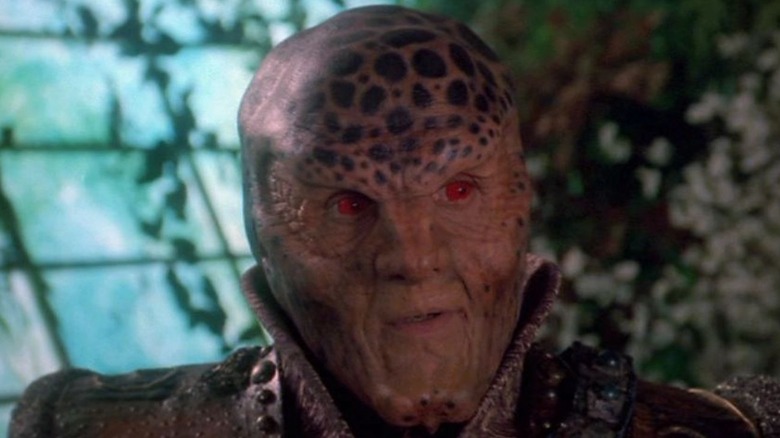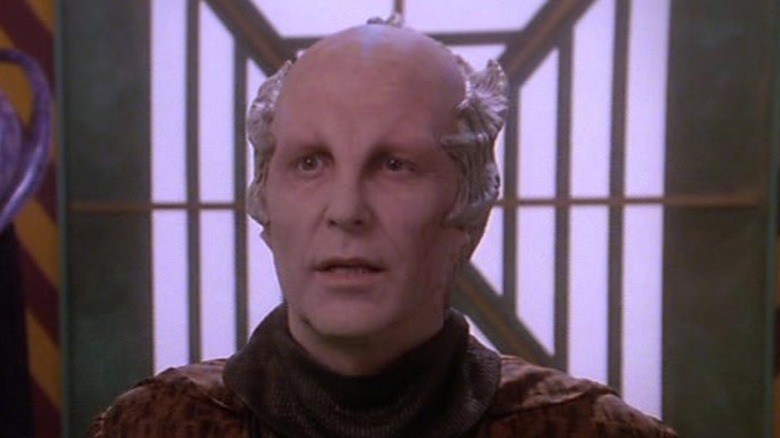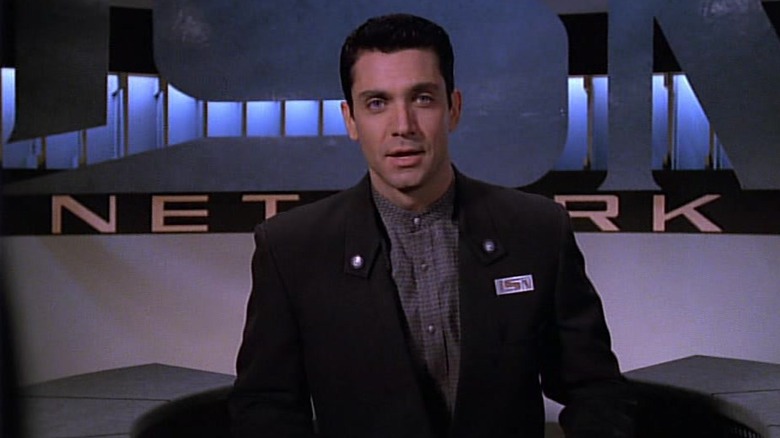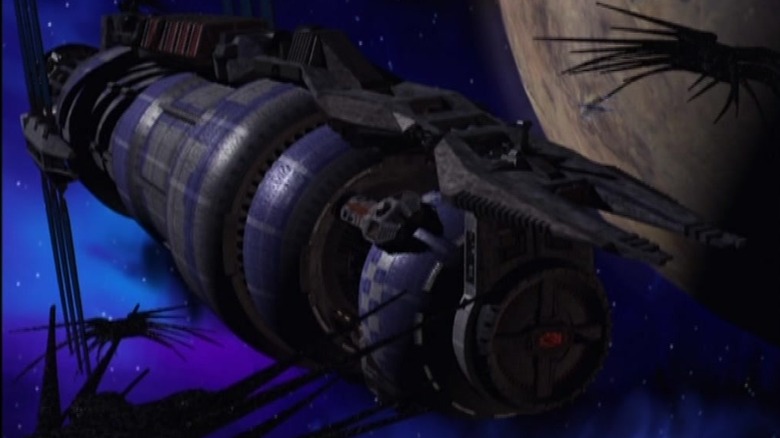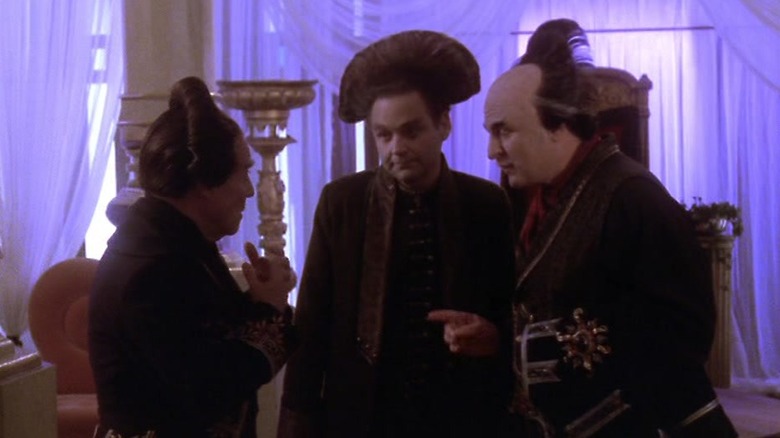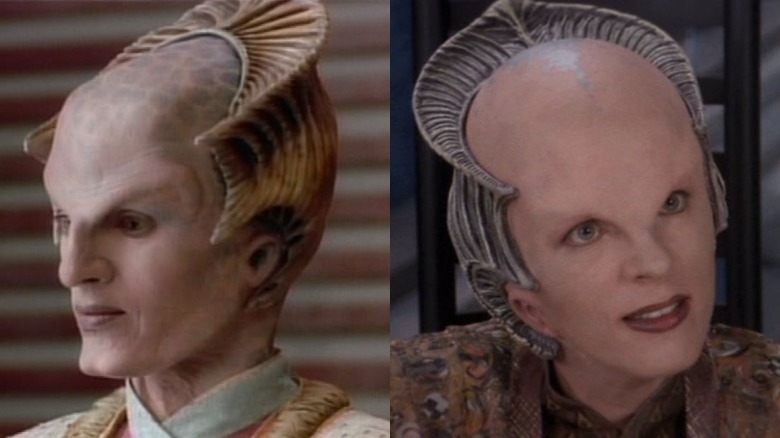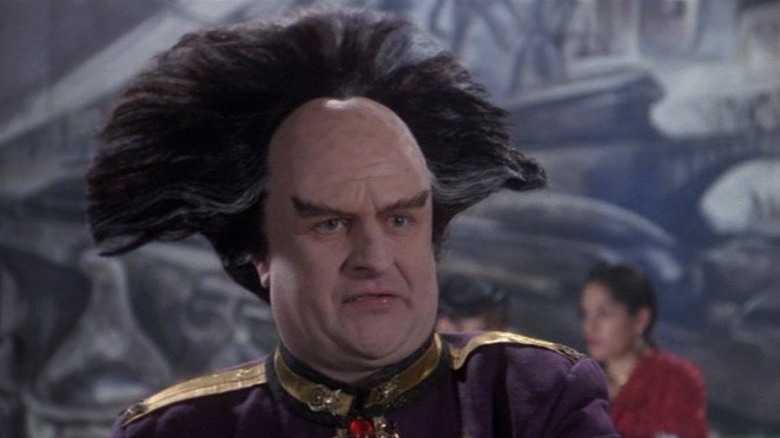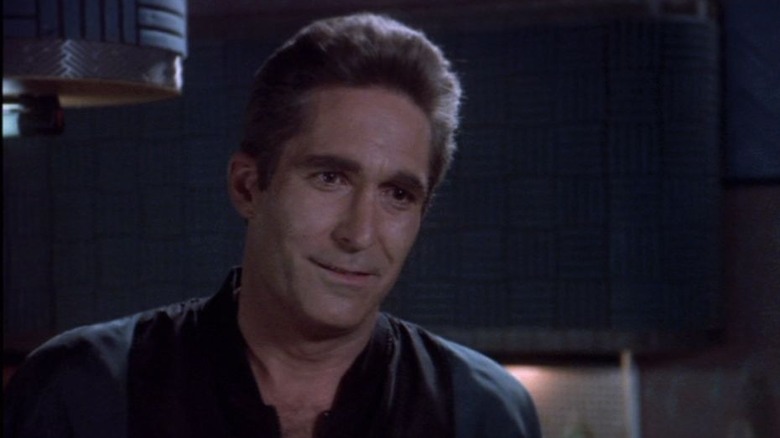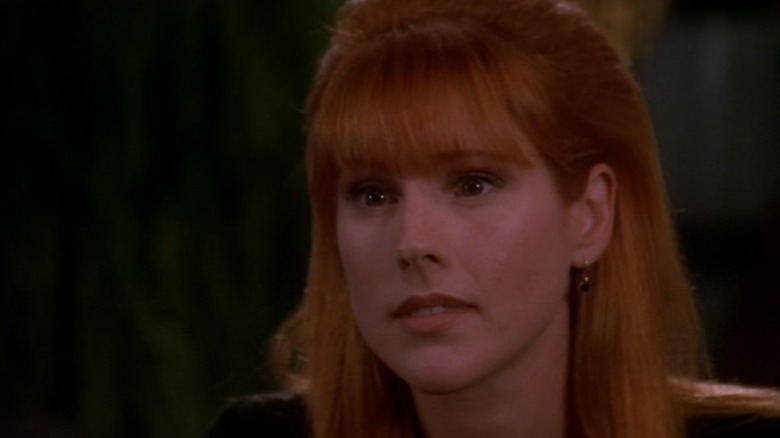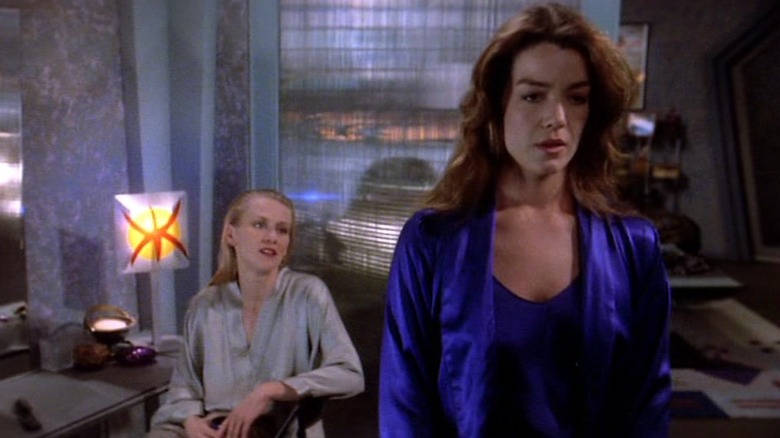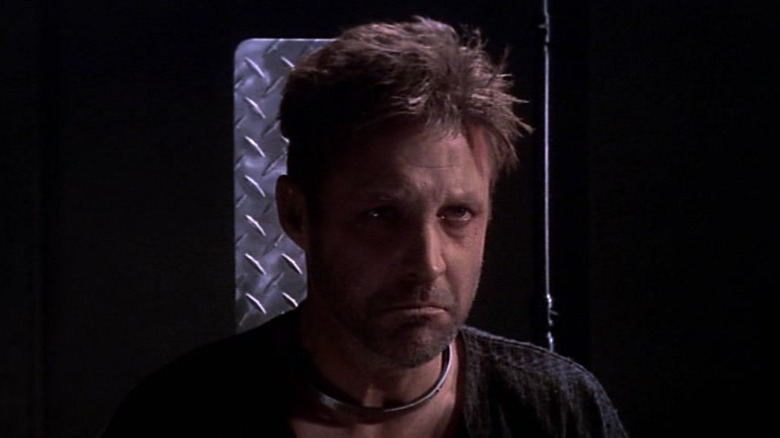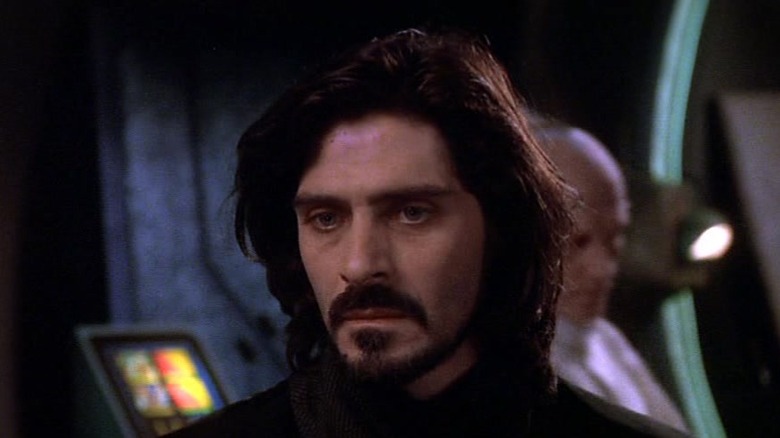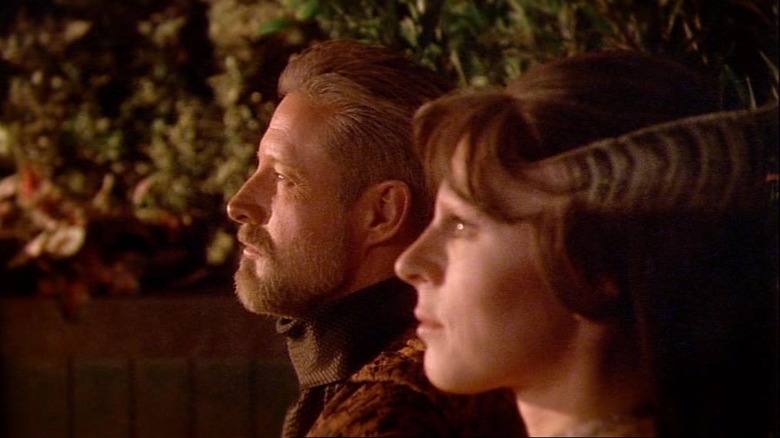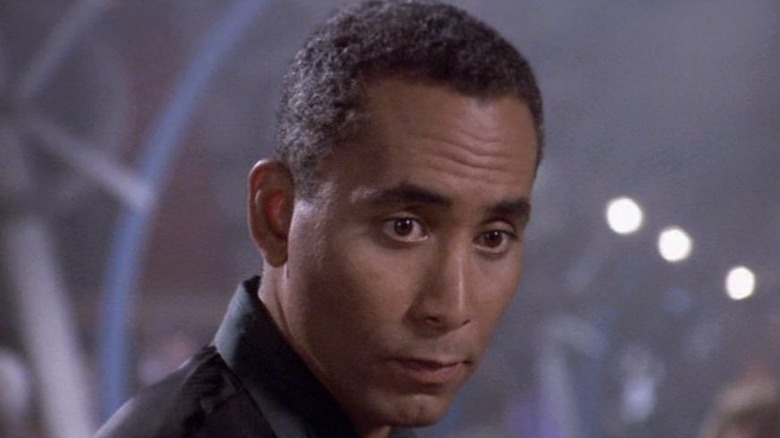The Untold Truth Of Babylon 5
In 1993, the fledgling Prime Time Entertainment Network debuted the pilot movie for "Babylon 5," a sci-fi television series of unprecedented scale and scope. The brainchild of writer/producer J. Michael Straczynski, "Babylon 5" is an exciting, mature, thought-provoking drama in space. The series is set in the 23rd century, when humans and an array of diverse alien cultures join together aboard a massive space station to conduct diplomacy and commerce. Their pursuit of peace is undermined by the patient manipulations of an ancient civilization called the Shadows who stoke old rivalries and provoke the galaxy into full-scale war.
"Babylon 5" is a complex tale told across 110 episodes, an early example of long-term serialized sci-fi storytelling on American television. Now that the TV landscape has caught up to its level of ambition, a fresh take on the series is being developed for The CW with the show's original creator on board to lead the writer's room. While we wait for the launch of a new "Babylon 5," fascinating tales from the production of the original series are still being uncovered.
The entire series was outlined ahead of time
J. Michael Straczynski wrote for a variety of television series in the 1980s, from genre cartoons like "He-Man and the Masters of the Universe" and "The Real Ghostbusters" to more conventional dramas like "Murder, She Wrote." While working on "Captain Power and the Soldiers of Fortune," a sci-fi adventure series for kids, Straczynski met producers Doug Netter and John Copeland, to whom he pitched an original space sci-fi series like nothing that had ever been produced before. Straczynski's concept, "Babylon 5," was far more intricately planned than is normally expected of a television series.
It's normal for a creator to compose a "series bible" outlining the world of the show, details about the characters, and examples for what future episodes might look like. But Straczynski took this several steps further and outlined five years of stories, setting up a beginning, middle, and end for the entire series and explaining every character's role for each step along the way. This document, written in 1989, would govern the series throughout its run from 1993 to 1999, though a lot of the details of the story would have to be changed to accommodate cast members leaving the show or other production concerns. Due to the challenge of keeping a writing staff apprised of his complex plans as well as the difficulty of keeping plot twists a secret from fans, Straczynski would end up writing 91 of the show's 110 episodes.
Babylon 5 was rejected by every major network
Creator J. Michael Straczynski and co-producers Doug Netter, John Copeland, and Evan Thompson spent years shopping the pitch for "Babylon 5" around Hollywood, armed with the pilot script, the intricate series bible, and concept art to help sell the story to executives. Everyone, from the old guard at CBS, the new Fox network, and HBO (who had yet to become known for prestige television) all turned it down.
"Babylon 5" was a tough sell, as space sci-fi television is very expensive to produce and executives felt that "Star Trek" was the only franchise with staying power. When the team pitched "Babylon 5" to Paramount Television, the studio that produced "Star Trek: The Next Generation" for syndication, Paramount held onto the story materials for nine months before Thompson finally asked for it back. This would stir speculation that Paramount mined the "B5" pilot script for ideas for the next "Star Trek" spinoff, "Deep Space Nine."
"Babylon 5" finally found a champion in Warner Bros. Domestic Television, who agreed to produce a pilot movie for the series for their new Prime Time Entertainment Network. PTEN would air the pilot and the first four seasons of "Babylon 5" before the network collapsed in 1998. The final season, along with several TV movies and the short-lived spinoff "Crusade," aired on the Warner-owned cable network TNT.
It pioneered the use of CGI on television
In the 1990s, space sci-fi television series like "Star Trek: The Next Generation" relied on the same techniques for depicting starships and alien worlds that had been in use on the big screen for decades. Spaceship effects were created using large models composited into environments using motion control cameras, a reliable but very expensive process innovated by the first "Star Wars" film in the mid-1970s. The popular method for creating exotic alien landscapes was even more old school: painting an environment on a pane of glass so that a camera can shoot through it, framing live-action elements inside.
In the interest of saving money and getting in on an innovative new technology, "Babylon 5" became an early adopter of computer-generated visual effects, not only for its space battles and establishing shots of the titular space station but also for set extensions. The entire show would hinge on this technology, and even visual effects designer Ron Thornton wasn't sure how he was going to pull off the visual effects when the project began. While the resulting CGI may not have held up terribly well by modern standards, they were ahead of their time in the mid-1990s, especially considering the show's budgetary limitations.
After three seasons of "Babylon 5," the distinguished competition over at Paramount would hire this same effects house, Foundation Imaging, to help expand the use of digital effects on their "Star Trek" TV franchise. "Babylon 5" would employ their own in-house effects team, Netter Digital, beginning with Season 4.
The production pinched every penny
"Babylon 5" might never have gotten the green light from Warner Bros. Television (and certainly wouldn't have lasted five seasons) if not for some creative cost-cutting techniques. Rather than utilizing the Warner Bros. studio lot, "Babylon 5" built their own studio space just outside of Los Angeles in what used to be a hot tub factory. That might sound more expensive than using an existing studio, but it allowed them to keep more of their sets standing and spend less time and money turning them around. The "B5" studio also enforced a much more strict schedule for shooting — where most dramas would shoot an episode over the course of eight 14-hour days, "Babylon 5" episodes were shot for seven days, for no more than 12 hours a day. Keeping to this schedule required a "measure twice, cut once" approach to production, and a regular, less grueling schedule was reportedly a morale-booster for the crew.
J. Michael Straczynski's obsessive story planning also helped keep the budget under control. While other series typically suffer from script rewrites during pre-production or even production of an episode, Straczynski was typically several weeks ahead with final scripts. Consequently, the crew rarely had to waste time and money preparing sets or props for scenes that would not end up in the final episode.
Costumes for civilian characters were often bought off the rack and then tweaked by costume designers rather than made from scratch. The crew never had to think twice about blowing up a starship or starfighter on the show, since they were always created digitally and there were no real models to destroy. Likewise, unlike on "Star Trek," "Babylon 5" could "kitbash" or tweak existing ship models to create unique designs without losing earlier versions.
Delenn was supposed to change gender during the series
In the pilot movie for "Babylon 5," the character of Minbari Ambassador Delenn is portrayed by the same actor as in the regular series, Mira Furlan, but sports a noticeably different alien make-up effect. In the pilot, Delenn's features are a bit more angular and traditionally masculine compared to the first season. This is because, originally, Delenn was to be a male character played by a female actor, which was believed would make him seem more alien. It was always the plan for Delenn to use a chrysalis to change physical form at the start of Season 2, but the original idea was that Delenn would emerge not only having become part human but also having changed gender.
This plan was abandoned during the production of the pilot movie when Straczynski and company found that the technology to remodulate Mira Fulan's voice down to a lower pitch made her too difficult to understand, particularly through her Croatian accent. Dialogue referring to Delenn by he/him pronouns was redubbed with she/her in post-production, and Delenn's makeup was redesigned to read as more feminine for the first season before being totally revised for the Minbari/human form used in the rest of the series.
Mira Furlan was relieved that there would be less manipulation of her performance onscreen, as she was feeling self-conscious about having her face, eyes, and even her voice totally altered. Each makeup revision allowed the audience to see more of Furlan, though the long-haired "hybrid" look for Delenn actually required her to spend more time in the make-up chair than the full alien headpiece she wore in the first season.
Londo's famous hair started out as a joke
One of the best "Babylon 5" characters is also one of the most silly-looking. Londo Mollari, first his planet Centauri Prime's Ambassador to Babylon 5 and later its Emperor, is instantly recognizable for the tall fan of hair that extends from the top of his scalp in the shape of a Napoleon hat. It's a tribute to actor Peter Jurasik's terrific performance that it's possible to take Londo seriously as a character despite this bizarre look.
According to series creator J. Michael Straczynski, Londo's signature hairstyle was the result of a comical misunderstanding. During the initial wig fitting for Jurasik during production of the pilot movie, the makeup artists applied an exceptionally tall wig to his head, intending to cut it down to the much more reasonable size suggested by the concept art. Before the wig could be modified, Jurasik got up from the makeup chair, found Straczynski, and told him how great he thought the huge wig looked.
"I didn't know he was kidding," Straczynski later told the Archive of American Television. The wig remained, and Londo and every other Centauri character would wear variations on this look in different shapes and sizes for the entire series.
The reason behind Michael O'Hare's departure was kept secret for years
The "Babylon 5" cast had an unusually high turnaround rate, with only half of the principal actors from the pilot movie remaining for the entire series. Most surprising was the departure of the show's original leading man, Michael O'Hare. After the end of the first season in 1994, series creator J. Michael Straczynski announced to fans on their Usenet message board that O'Hare would be leaving the series on friendly terms. His character, Commander Jeffrey Sinclair, was written out of the series, returning for a brief cameo in Season 2 and a two-episode arc one year later to wrap up some threads left dangling by his departure. Otherwise, he was replaced on the series by Bruce Boxleitner as the new Captain John Sheridan.
After O'Hare's death from a heart attack in 2012, Straczynski revealed the hidden details behind O'Hare's departure from the show. During production of the first season, Straczynski (who has a bachelor's degree in psychology) noticed that O'Hare had begun to suffer from paranoid delusions on set and that his condition was worsening due to the stress of shooting the series. O'Hare and Straczynski worked together to try and keep the show on the rails for the rest of the season, but it was clear that O'Hare's mental health was in serious jeopardy. In an effort to save the show, protect O'Hare's career, and ensure he could get the help he needed, Straczynski wrote Commander Sinclair off the show and helped O'Hare get treatment for his condition during his absence from the series. This absence turned out to be permanent.
Straczynski offered to keep O'Hare's secret to his grave, to which he says O'Hare replied, "Take this to my grave," granting Straczynski permission to share his story should he predecease him.
More cast departures affected the flow of the story
When J. Michael Straczynski outlined five years of "Babylon 5" in advance, he knew that the realities of television would likely prevent him from telling the story exactly as designed. He had longterm plans for each character but could not count on every actor cast at the start of the series to remain for the entire five years, so he devised a series of "trap doors" that would allow characters to exit the story while passing off indispensable story threads to other characters. This planning came in handy at multiple junctures throughout the series, and with some improvisation, the story was able to continue despite multiple surprise cast changes. Thanks to Straczynski's unprecedented transparency with fans during and after the run of the series, fans have compiled a thorough list of every "trap door" that Straczynski has revealed over the years, including a few that were never activated.
For instance, multiple cast members were lost between the production of the pilot movie and the first season. During the pilot, Dr. Kyle and Lyta Alexander become the only humans to see the true form of the secretive Vorlon Ambassador Kosh. When neither character's actor was hired to return for the series, this coincidence became rolled into the plot, creating a connection between their Vorlon encounter and their absence. Lyta Alexander was replaced by a new resident telepath Talia Winters, who would fulfill Lyta's original planned story arc — that is, until Talia's actor also left the show, leading Lyta to return and pick up her story where Talia left it.
Susan and Talia's romance was cut short
In the Season 2 episode "Divided Loyalties," Babylon 5's resident licensed telepath Talia Winters is exposed as a sleeper agent for the sinister Psi Corps, leading to her permanent departure from the station and the show. Talia was written off the series due to actor Andrea Thompson pursuing another job opportunity, but she gave the producers enough advance notice that they could fast-track part of her intended storyline and hand the rest of it off to her successor.
One such story thread that was meant to play out over a longer period of time was Talia's relationship with Lt. Commander Susan Ivanova, which began as icy but was going to gradually build into a full-on romance. Due to Thompson leaving the show, writer J. Michael Straczynski decided to accelerate the pace of their relationship by about nine episodes and very heavily imply that they'd slept together in "Divided Loyalties." Talia's telepathic betrayal, which was one of Straczynski's famous "trap doors" to allow a character to leave the show, would not have happened if Thompson had remained in the cast, which may have allowed Talia and Susan's relationship to continue to evolve on screen.
Both Thompson and Ivanova's performer Claudia Christian, who were good friends on set, were entirely game to depict their characters as being in a relationship, in fact Thompson was disappointed in the producers' decision not to show an onscreen kiss between the two women. A future episode would, through dialogue, remove the last layer of ambiguity about the nature of their relationship, and Christian has since proudly described Ivanova as "the first bisexual Russian Jew in space."
Claudia Christian was shot by a viewer
Actor Claudia Christian, who portrayed Commander Susan Ivanova, was once shot by a fan at a sci-fi convention. In interviews, as well as in her memoir "Babylon Confidential," Christian has described receiving a variety of hand-knitted gifts by mail from a fan who happened to work for the US Postal Service. Eventually, at a convention in upstate New York, this fan approached her to deliver his latest gift (an "awful" hot-pink and lime-green afghan) in person, dressed in a giant Tribble costume. Christian accepted the monstrosity graciously nevertheless.
Later, the fan approached Christian a second time, with his Tribble costume now covered in lights, wires, and fake blood. The fan pulled out a gun and shot Christian with a blank round at close range, which is extremely dangerous and potentially life-threatening. Luckily, she suffered only minor injuries; she decided not to press charges against her assailant. Years later, at another convention appearance, this same fan approached Christian again and apparently assumed that she wouldn't remember their previous meeting.
The threat of cancellation accelerated the pace of the story
During the production of Season 4, J. Michael Straczynski and the other storytellers on "Babylon 5" had no guarantee that the series would be renewed for its planned fifth and final season. Its home network, PTEN, was about to collapse, and it was unclear whether or not another network would rescue the show. Rather than cross their fingers and hope for the best, Straczynski and company chose to restructure the fourth season so that it would wrap up all the essential series storylines and leave the audience with a satisfying conclusion at the end of Season 4. This brisk pace is noticeable even from the start of the season, which wraps up its long-running Shadow War storyline within just six episodes. The rest of the season would be dedicated to Babylon 5's conflict with EarthGov and the revolution against the corrupt President Clark.
The original plan was for Season 4 to end with the episode "Intersections in Real Time," which finds Sheridan in a prison for his insurrection against EarthGov. When the decision was made to compress the entire season to fit two years' worth of storylines, the plot was accelerated to place "Intersections" four episodes before the end and cram what would have been the first chunk of the fifth season into the end of the fourth. Straczynski still had stories left over to use in a fifth season, which was eventually aired on TNT.
Marcus almost survived the series
In "Rising Star," the penultimate episode of Season 4, Lt. Commander Ivanova has suffered critical injuries in the final battle of Babylon 5's war with Earthgov and stands at the brink of death. Stalwart Ranger Marcus Cole, who is in love with Ivanova, uses an alien device to give her his life energy, saving sacrificing himself to save her. Even at the point this episode was filmed, J. Michael Straczynski wasn't completely sure about killing off Marcus, going so far as to film to different endings for the episode — one in which he dies, and one in which both characters survive the life energy transfer. Straczynski eventually decided this would be too cheap, as he'd set up this story to have mortal stakes and not killing off either character would rob it necessary gravity.
Ironically, Ivanova's actor, Claudia Christian, did not renew her contract going into Season 5 (Christian and Straczynski's accounts of her departure are quite different) and was replaced by a new character, Captain Elizabeth Lochley. If Straczynski had known this would happen before the end of the previous year, it's likely he would have simply allowed Ivanova to die her hero's death and keep Marcus alive rather than losing both characters due to real-world cast complications.
The series finale was actually shot during the fourth season
"Babylon 5" was officially rescued from cancellation after filming for the fourth season had already wrapped, including production for the intended series finale, "Sleeping in Light." "Sleeping in Light" is set 20 years after the rest of the series, depicting John Sheridan's final days and a last supper of sorts with his closest friends that reveals the destinies of most of the main characters. With the show coming back for a fifth season, this episode would have to be kicked down the road, meaning the fourth season would need a new installment to complete its 22-episode order.
"The Deconstruction of Falling Stars" was produced as the first episode in TNT's order for a fifth season, but aired on time as the capstone to Season 4. The story is set in the distant future, tracing the reverberations of the protagonists' actions over the course of an entire millennium. While the haste of its conception and production certainly shows, it's still an interesting teaser for the stories yet to come in the final season and a curious epilogue to "Babylon 5" as a whole. Most importantly, it allowed the storytellers to save the more profound emotional closure of "Sleeping in Light" for the end of the series, where it belongs.
A shocking percentage of the cast has died
The final episode of "Babylon 5" takes place 20 years after the rest of the story, revisiting many of the main characters as they enjoy late middle age. Sadly, in that same distance in real time from the end of production of the series, an upsetting number of the show's stars have already passed away.
In 2004, actor Richard Biggs, who portrayed Dr. Stephen Franklin on all five seasons of "Babylon 5," died suddenly at the age of 44. In 2006, Andreas Katsulas, the show's beloved Narn Ambassador G'Kar, died at 59 of lung cancer. Series regulars Jeff Conaway and Jerry Doyle, who played security officers Zack Allan and Mike Garibaldi, died in 2011 and 2017 respectively, both from complications related to substance abuse. Original star Michael O'Hare suffered a fatal heart attack in 2012. Stephen Furst, who played the meek Centauri diplomat Vir Coto for five seasons, passed away from diabetes complications in 2017. In 2021, Delenn actor Mira Furlan succumbed to West Nile virus at the untimely age of 65, still the longest-lived of any of her late co-stars.
As of 2021, of the seven actors who appear in the opening credits of all five seasons of "Babylon 5," only Peter Jurasik (Londo Mullari) and Bull Mumy (Lennier) remain.
